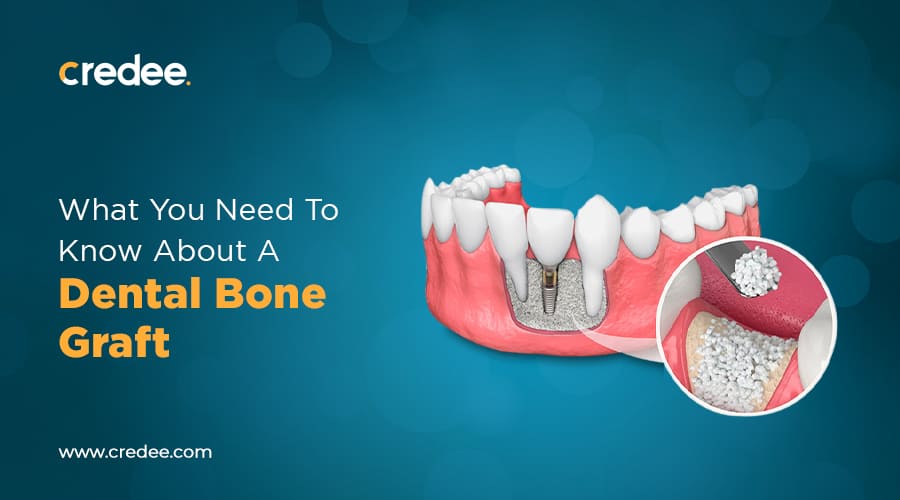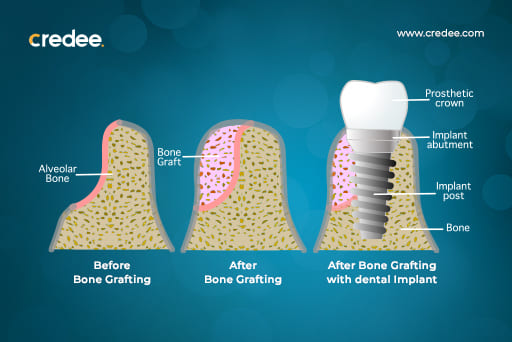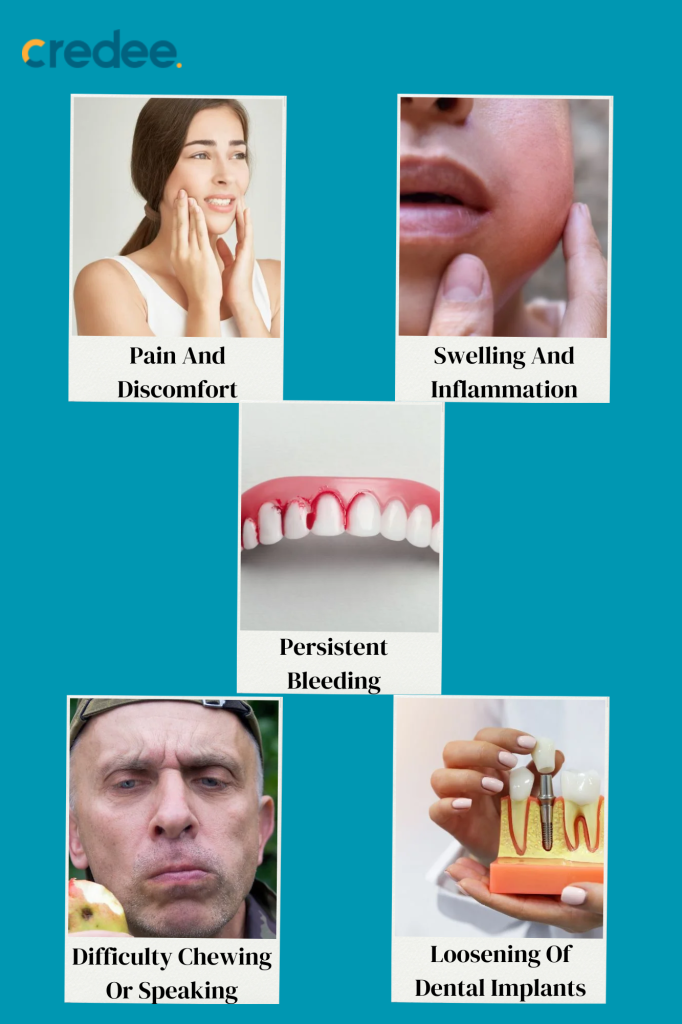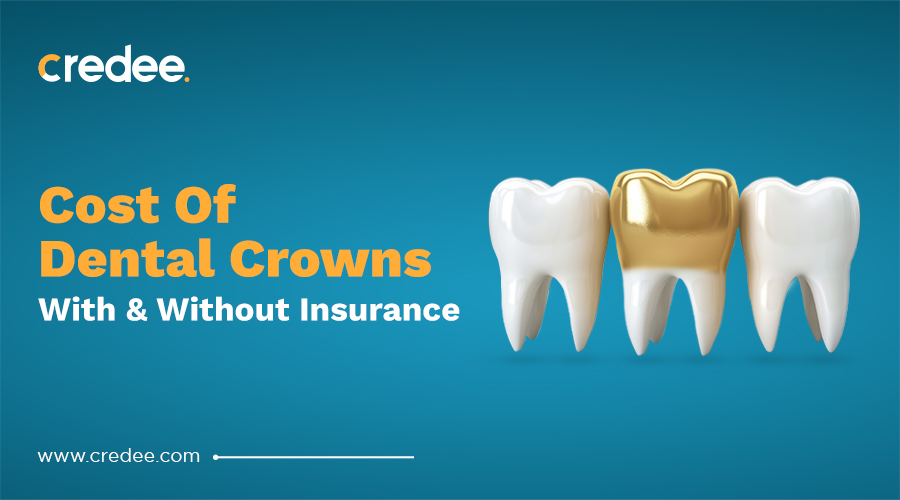
A dental bone graft is typically performed when you have missing teeth and are considering dental implants. This procedure helps to regenerate and strengthen the jawbone, providing a solid foundation for implants. The demand for dental bone grafts is rising, and according to WorldMetrics, the global dental bone graft market is projected to grow to $1,371.2 million by 2030.
What Is A Dental Bone Graft?
A dental bone graft is a surgical procedure performed to enhance the bone in the jaw where the bone is lost. Your dentist may suggest this procedure before a dental implant to improve the aesthetics of your mouth or to secure your current teeth if you have suffered bone loss.
Are You An Ideal Candidate For A Dental Bone Graft? Let's Find Out!
You might be a perfect candidate for a dental bone graft if you have any of the following conditions:
✅ Multiple Missing Teeth
If you need dental implants to replace missing teeth, a bone graft can provide the necessary support.
✅ Bone Loss
If you've suffered jawbone injury, have poor dental hygiene, or have experienced bone loss affecting your appearance, a bone graft can help restore your jawbone structure.
✅ Gum Disease
If gum disease has caused significant bone loss around your teeth, a bone graft can prevent further damage and support the health of your remaining teeth.
Learn About Wisdom Teeth Removal Costs and Payment Options.
Dental Bone Graft Cost: What You Need To Know
The dental bone graft costs can vary depending on the condition of the patient’s jawbone. If a bone graft is done from a synthetic bone, it can cost between $500 to $2,700. If the bone graft material is sourced from the patient, hospitalization is required, increasing the costs.
Here are some of the reasons for this price variation:
▪ Type of bone graft used
▪ Expertise of the dental surgeon
▪ Difficulty level to reach the graft site
▪ Number of sites receiving the bone graft
▪ Quantity of bone graft material used
Types Of Dental Bone Grafts
A dental bone graft can cost between $500 and $4,000 on average. Below are the types of bone grafts along with their average cost.
| Type Of Bone Graft | Average Cost Per Graft |
|---|---|
| Alloplast (synthetic bone material) |
$600 to $2,000 |
| Allograft (uses bone from a human donor) |
$700 to $2,500 |
| Autograft (uses bone from your own body) |
$1,500 to $4,000 |
| Xenograft (uses bone from an animal) |
$750 to $2,700 |
Dental Bone Graft Procedure
Here’s how the dental bone graft process works:
➡ The dental surgeon inspects your gums and jaws and reviews the X-rays or scans to ascertain the bone loss.
➡ The surgeon will create a personalized treatment plan and discuss the options with you.
➡ You will be administered local anesthesia to numb the area.
➡ The gum tissue is cut open to expose the jawbone.
➡ The bone grafting material is added to the area and the incision is closed with stitches.
Dental Bone Graft Risks And Benefits
Dental bone grafts come with both risks and benefits. It's important to weigh these factors carefully and discuss them with your dentist or oral surgeon before deciding whether a dental bone graft is right for you.
5 Key Benefits Of Dental Bone Grafting
▪ Restores the jawbone to its original form
▪ Holds the gums and teeth in place
▪ Lifts your facial muscles and prevents sagging and thinning lips
▪ Supports dental Implants and bridges
▪ Saves teeth from shifting
The Risks
The procedure is usually safe, however, it carries certain risks:
▪ Damage to nerve
▪ Bleeding
▪ Anesthesia-related complications
▪ Infection
Dental Bone Graft Before And After
Witness the dramatic transformation: before and after images capture the remarkable outcomes of dental bone graft surgery.

✅ Care After Bone Grafting
Following a certain regime after a bone graft surgery is imperative for better healing and preventing complications. Here are some instructions to follow post-op:
✅ Diet
It is suggested to have a balanced diet after the surgery which includes soft foods like porridge, eggs, and yogurt. Additionally, avoid extremely hot or cold drinks and food, carbonated drinks, and alcoholic beverages.
✅ Mouth Rinses
To let the blood clot stabilize, avoid thorough rinsing for the next two days and use warm salt water to rinse the mouth. Gently brush your teeth, without disturbing the graft site and avoid touching the incision area with your tongue.
✅ Swelling
Swelling post-surgery is normal and it may take 48 hours to go away. To minimize swelling, apply cold compressions for the initial 48 hours or as suggested by the surgeon. Elevate your head when lying down as it minimizes facial swelling.
✅ Pain Management
You will experience a certain degree of pain after the surgery but the good news is you can overcome it with pain relievers. Your surgeon will prescribe over-the-counter medicines that can be taken when there is extreme pain.
✅ Smoking
Do not smoke or consume alcohol for at least three weeks as it may result in delayed healing.
Recovery After Dental Bone Graft Procedure
The dental bone graft healing may take up to 3-9 months, depending on individuals and factors such as the type of bone graft, graft site, and patient’s healing ability.
Dental Bone Graft Healing Stages
Once the tooth bone graft is done, it is left to heal. There are three main healing stages:
Stage 1: Recovery Phase (Week 1-2)
During this stage, the blood vessels supply oxygen to the graft site, thus, beginning the healing and preparing the area for bone regeneration.
Stage 2: Repair Phase (Week 3-6)
New bone tissues start forming at the graft site, indicating that your body is accepting the graft.
Stage 3: Integration Phase (Over 6 months)
In the integration phase, the new graft is replaced with a dense bone, gradually gaining strength and stability.
Indicators Of Dental Bone Graft Complications
While bone grafts typically have a high success rate, individuals with certain medical conditions may experience complications. Warning signs of potential bone graft failure include:
▪ Persistent swelling and inflammation around the graft site
▪ Continuous bleeding that does not subside within a few hours
▪ Severe pain at the graft site
▪ Instability in dental implants
▪ Difficulty chewing food properly and discomfort while speaking
Failed Dental Bone Graft Healing Pictures
Images of failed dental bone grafts often show significant swelling, redness, and sometimes visible infection around the graft site. These pictures help dentists spot problems early and decide how to fix them. Recognizing these signs is important for quick treatment and a successful recovery.

Financing Options For Dental Bone Grafts
The initial upfront cost of the dental bone graft is substantial, therefore, several individuals seek financing options to make it more reasonable for their pockets. Some options include:
1. Medical Credit Card
A medical credit card is especially suited for your healthcare-related expenses. These cards help you pay for several medical treatments including dental bone grafts, cosmetic procedures, and dental care. Medical credit cards are widely accepted at healthcare and dental clinics and hospitals. However, they have stringent requirements and their approval depends on the patient’s creditworthiness.
2. Personal Loans
Seeking financing for dental bone graft surgery can be cumbersome as it involves extensive paperwork and credit checks. Patients must go through the long application process and provide detailed financial information to lenders. Defaulting a personal loan payment can lead to serious penalties, including late fees and increased interest rates.
3. Flexible Payment Plans
Flexible payment plans for dental bone graft surgery offer patients a practical alternative when other options fall short. Unlike upfront payments or loans, these plans break down the total cost of the procedure into manageable installments spread over an agreed-upon period, alleviating the burden of immediate payback.
What makes these plans particularly appealing is the absence of credit checks, making them accessible to individuals regardless of their credit history. Patients have the flexibility to choose from several payment options, allowing them to select a plan that best fits their budget and financial situation. This approach not only makes dental care more affordable but also ensures that patients can undergo necessary procedures without worrying about the financial implications upfront.
Takeaway
Dental bone grafting is a crucial procedure for those seeking to restore their jawbone's integrity, enhance dental aesthetics, and secure implants. Despite the high success rate, it is essential to be aware of potential complications and adhere to post-operative care instructions to ensure optimal healing.
The cost of the procedure varies widely, influenced by the type of graft, the surgeon's expertise, and the complexity of the case. However, with the rising demand for dental bone grafts, financing options like medical credit cards, personal loans, and flexible payment plans can make this important procedure more accessible. Understanding the benefits, risks, and recovery process empowers patients to make informed decisions about their dental health.
Don't let financial constraints prevent you from achieving a healthier, more confident smile. Explore Credee's flexible dental payment plans today to find a solution that fits your budget and ensures you get the care you need without delay. Start your journey towards a stronger, more beautiful smile now!
FAQs
1. When Can I Go Back To Work?
You can return to work in 3-4 days, depending on the condition of your graft site.
2. Are You Put To Sleep For A Dental Bone Graft?
Whether you are put to sleep for a dental bone graft is typically determined by the complexity of the procedure and patient preferences, in conjunction with guidance from the oral surgeon.
3. Why Do You Need A Bone Graft After Tooth Extraction?
A dental bone graft becomes necessary after tooth extraction because it stops further jaw bone loss and promotes its growth. Additionally, it creates a foundation to support dental implants.
4. How Long Is The Dental Bone Graft Healing Timeline?
A dental bone graft may take up to 6 months to heal completely. To speed up the healing process, follow your surgeon's advice and refrain from smoking and alcohol.
5. How Much Is The Recovery Time After A Dental Bone Graft?
Complete healing post-surgery may take up to 9 months as the bone graft takes time to fuse with the jawbone.
6. How Much Does A Dental Bone Graft Cost?
The price of a dental bone graft varies depending on factors such as the procedure complexity, materials utilized, and your location. Typically, the cost falls within the range of $500 to $4,000.
7. Is Tooth Extraction With Bone Graft Painful?
The procedure is not painful as you'll be sedated but, as the anesthesia wears off, you can experience some level of discomfort. Your surgeon will prescribe pain relievers to minimize pain.
8. How Much Does A Bone Graft Cost Without Insurance?
A dental bone graft without insurance averages $5,000. It is always advisable to check with your insurance provider for the terms of coverage.
9. Is Bone Grafting Necessary After Every Tooth Extraction?
Not all extractions require bone grafting. It's often necessary if you plan to get a dental implant afterward. After a tooth is removed, rapid bone loss can occur in the area. Whether a bone graft is needed depends on the specific case. Your dentist might use X-rays to check bone loss and decide if a graft is needed, especially if there's significant bone loss due to gum disease.
10. My Dental Bone Graft Membrane Is Falling Out. What Can I Do?
If your dental bone graft membrane is falling out, contact your dentist or oral surgeon right away. Meanwhile, avoid touching or disturbing the area with your tongue or fingers to prevent further issues or infection.
11. How Can I Pay For The Dental Bone Grafting Procedure?
Covering the cost of the procedure is straightforward with Credee's flexible financing options. These payment plans divide the overall expense into smaller, more manageable installments. Plus, Credee offers instant approval without credit checks, making it simple to secure the necessary funding.
12. What Are The Alternatives To Bone Grafting?
If you plan to get dental implants and do not have sufficient jawbone to support them, it may not be possible without bone grafting. But, here are some alternative options:
✅ Full Arch Prostheses
This method of restoration is best suited for individuals with sufficient jawbone. The tooth roots are surgically placed in the jawbone using all-on-4 or all-on-6 dental implants.
✅ Zygomatic Implants
The prostheses are embedded in the cheekbone using two metal connectors, supporting dental prostheses in the upper jaw.
13. Can The Procedure Be Undertaken Without General Anesthesia?
Yes, it is possible. Oral sedation can be used in place of anesthesia if you are comfortable with it. You can talk to your surgeon about it and discuss it further.
14. What Is The Lifespan Of A Dental Bone Graft?
Dental bone grafts have a high success rate, but how long they last can vary for each patient and is hard to predict. Schedule regular appointments with your surgeon to check on the health of your dental bone graft.
Worried about Dental Bone Graft Costs? Explore affordable solutions.
Schedule A Demo


